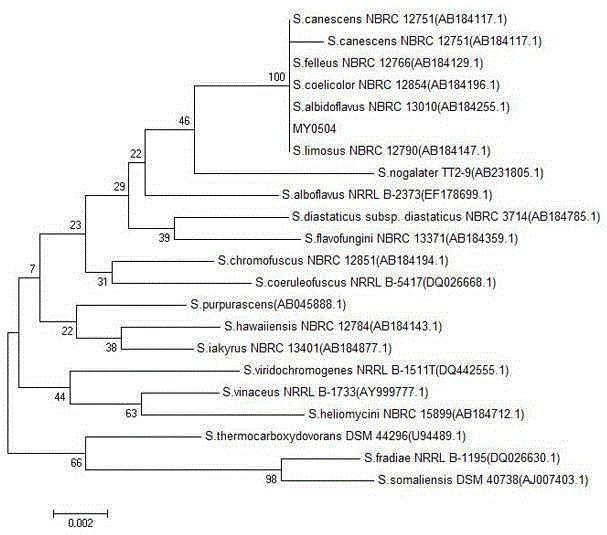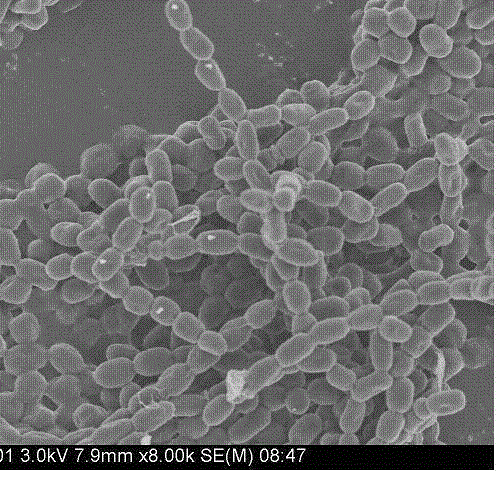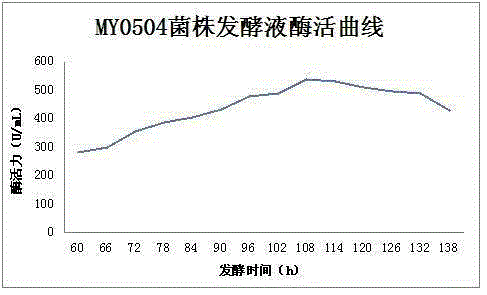Ocean actinomycetes strain producing plasmin, application and plasmin prepared from same and application of plasmin
A marine actinomycete and plasmin technology, applied in the field of bioengineering, can solve the problems of high price, shortage of sources, short half-life, etc., and achieve the effect of safety and reliability for the environment and operators
- Summary
- Abstract
- Description
- Claims
- Application Information
AI Technical Summary
Problems solved by technology
Method used
Image
Examples
Embodiment 1
[0023] Embodiment 1, strain MY0504 isolation and screening
[0024] 1. Preservation of seawater and sea mud samples:
[0025] Seawater was sampled in 200ml per bottle, refrigerated first, and then each bottle was divided into sterilized centrifuge tubes (50ml), and one bottle was taken for experiments, and the rest were stored in liquid nitrogen for repeated or further screening.
[0026] 2. Sample pretreatment
[0027] Take 1ml of seawater samples from different bottles, take 10ml for every 10 bottles, combine and mix, and set aside; weigh about 10g of sea mud samples or animal belt silt, mix them, and then mix them with simulated seawater at a ratio of 1:5 (W / W) mixing, shaker shaker 30min, standby.
[0028] 3. Primary screening of protease strains
[0029] Take sea mud samples and add sterilized K 2 Cr 2 o 7 (Potassium dichromate) solution to make the concentration reach 800 μg / ml, shake at 25°C for 8 hours, apply protease medium (LB solid medium with 0.5% sterilized...
Embodiment 2
[0037] Embodiment 2, identification of bacterial strain MY0504
[0038] 1. Morphological characteristics
[0039] Strain MY0504 was cultured in seawater LB medium at 26°C for 48 hours, the colony was milky white, dry, and the spores were oval and smooth.
[0040] 2. Physiological and biochemical properties
[0041] The cultureable condition of the bacterial strain is temperature 15-40 DEG C, pH 6-14, salt (NaCl) concentration 1%-10%. Other physiological and biochemical indicators are shown in Table 2, and the experimental methods are routine microbial physiological and biochemical characteristics experiments.
[0042] Table 2: Physiological and biochemical experimental results of plasmin strains
[0043]
[0044]
[0045] 3. 16SrRNA
[0046] The determination of 16SrRNA sequence was completed by Treasure Bioengineering (Dalian) Co., Ltd. Blast the spliced sequence on the CNBI website for similarity comparison. The strain MY0504 is highly related to the strain of S...
Embodiment 3
[0048] The preparation of embodiment 3 plasmin fermented liquid
[0049] The colony spores of MY0504 obtained by screening in Example 1 were picked, inserted into LB seawater medium, and then fermented.
[0050] The composition of the LB seawater medium is: peptone 10g L -1 , yeast extract powder 5g·L -1 , pH7.0-7.2, the balance of seawater or simulated seawater. The simulated seawater can be formulated with the following ingredients:
[0051] Proportion of simulated seawater (g / L):
[0052] NaCl26.73, MgCl 2 2.26, MgSo 4 3.25, CaCl 2 1.15
[0053] NaHCO 3 0.198, KCl0.721, NaBr0.058, Al 2 Cl 6 0.013
[0054] NaSiO 3 0.0024,H 3 PO 4 0.002, NH 3 0.002, LiNO 3 0.0013.
[0055] The volume of culture medium in the Erlenmeyer flask was 100mL / 500mL, cultured at 25°C for 3-4 days, the shaker speed was 140r / min, with urokinase as the standard control, and the fermentation level of plasmin was about 500U / mL.
[0056] Stock solution A (fermentation liquid containing bacte...
PUM
 Login to View More
Login to View More Abstract
Description
Claims
Application Information
 Login to View More
Login to View More - R&D
- Intellectual Property
- Life Sciences
- Materials
- Tech Scout
- Unparalleled Data Quality
- Higher Quality Content
- 60% Fewer Hallucinations
Browse by: Latest US Patents, China's latest patents, Technical Efficacy Thesaurus, Application Domain, Technology Topic, Popular Technical Reports.
© 2025 PatSnap. All rights reserved.Legal|Privacy policy|Modern Slavery Act Transparency Statement|Sitemap|About US| Contact US: help@patsnap.com



